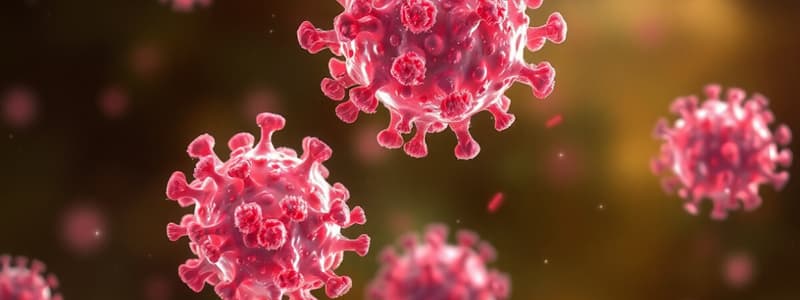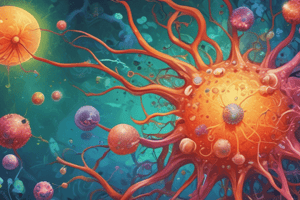Podcast
Questions and Answers
Which immunoglobulin class is primarily responsible for protecting mucous membranes and internal cavities from infection?
Which immunoglobulin class is primarily responsible for protecting mucous membranes and internal cavities from infection?
- IgE
- IgA (correct)
- IgG
- IgD
Immunoglobulin D (IgD) is the first antibody produced during an infection.
Immunoglobulin D (IgD) is the first antibody produced during an infection.
False (B)
What is the primary function of IgE?
What is the primary function of IgE?
IgE is involved in allergic reactions, drug sensitivity, anaphylaxis, and immediate hypersensitivity. It also helps fight parasitic diseases.
The ______ class of antibodies is known for enhancing phagocytosis, neutralizing toxins and viruses, and protecting the fetus and newborn.
The ______ class of antibodies is known for enhancing phagocytosis, neutralizing toxins and viruses, and protecting the fetus and newborn.
Match the immunoglobulin class with its correct location:
Match the immunoglobulin class with its correct location:
Which of the following is NOT a function of antibodies?
Which of the following is NOT a function of antibodies?
Immunity is only obtained through vaccination.
Immunity is only obtained through vaccination.
What is the definition of immunity?
What is the definition of immunity?
What is the primary function of the thymus?
What is the primary function of the thymus?
The spleen weighs approximately 500 grams in adults.
The spleen weighs approximately 500 grams in adults.
What term is used to describe the body's ability to distinguish between 'self' and 'non-self'?
What term is used to describe the body's ability to distinguish between 'self' and 'non-self'?
T lymphocytes mature in the ______.
T lymphocytes mature in the ______.
Match the immune organs with their primary functions:
Match the immune organs with their primary functions:
What is an antigen?
What is an antigen?
Autoimmune diseases occur when the immune system attacks 'non-self' cells.
Autoimmune diseases occur when the immune system attacks 'non-self' cells.
What does MHC stand for?
What does MHC stand for?
Which type of vaccine contains living, non-virulent strains of microbes?
Which type of vaccine contains living, non-virulent strains of microbes?
The oral polio vaccine contains killed poliomyelitis viruses.
The oral polio vaccine contains killed poliomyelitis viruses.
Name one vaccine that uses recombinant DNA technology.
Name one vaccine that uses recombinant DNA technology.
Diphtheria and tetanus vaccines are examples of ______ vaccines.
Diphtheria and tetanus vaccines are examples of ______ vaccines.
Which of the following is an example of a vaccine containing killed organisms?
Which of the following is an example of a vaccine containing killed organisms?
Passive immunity provides long-term protection against infections.
Passive immunity provides long-term protection against infections.
Match the following types of vaccines with their descriptions:
Match the following types of vaccines with their descriptions:
What is the function of the immune globulin (IG) in passive artificially acquired immunity?
What is the function of the immune globulin (IG) in passive artificially acquired immunity?
What type of antigen is involved in allergic reactions?
What type of antigen is involved in allergic reactions?
The immune system does not differentiate among different types of pathogens.
The immune system does not differentiate among different types of pathogens.
Where do T cells mature?
Where do T cells mature?
B cells and T cells are types of ______ involved in the immune response.
B cells and T cells are types of ______ involved in the immune response.
Match the following T cell types with their functions:
Match the following T cell types with their functions:
What is the primary role of Helper T cells?
What is the primary role of Helper T cells?
Cytotoxic T cells are specialized in attacking cells infected by viruses and bacteria.
Cytotoxic T cells are specialized in attacking cells infected by viruses and bacteria.
What process involves a phagocyte displaying an antigen fragment from an invader?
What process involves a phagocyte displaying an antigen fragment from an invader?
What protein do cytotoxic T cells release to lyse infected cells?
What protein do cytotoxic T cells release to lyse infected cells?
Suppressor T cells are responsible for activating the immune system during an infection.
Suppressor T cells are responsible for activating the immune system during an infection.
What is the primary function of plasma cells?
What is the primary function of plasma cells?
B lymphocytes are formed in the _______.
B lymphocytes are formed in the _______.
Which type of immune response involves B cells?
Which type of immune response involves B cells?
Memory T cells do not play a role in immunity.
Memory T cells do not play a role in immunity.
What happens to B cells after they are activated by helper T cells?
What happens to B cells after they are activated by helper T cells?
What type of immunity involves the transfer of antibodies from mother to fetus across the placenta?
What type of immunity involves the transfer of antibodies from mother to fetus across the placenta?
Artificially acquired active immunity is usually long-lasting.
Artificially acquired active immunity is usually long-lasting.
What is the main difference between naturally acquired active immunity and artificially acquired active immunity?
What is the main difference between naturally acquired active immunity and artificially acquired active immunity?
The immunity obtained from colostrum during breastfeeding is called ___________.
The immunity obtained from colostrum during breastfeeding is called ___________.
Match the immunoglobulin types with their modes of transfer:
Match the immunoglobulin types with their modes of transfer:
Which of the following is an example of artificially acquired passive immunity?
Which of the following is an example of artificially acquired passive immunity?
Antiserum is a type of actively acquired immunity.
Antiserum is a type of actively acquired immunity.
What type of vaccine contains weakened pathogens?
What type of vaccine contains weakened pathogens?
Flashcards
Allergen
Allergen
Antigen that triggers an allergic reaction, often to harmless substances like egg.
Immune system
Immune system
The body's third line of defense, specifically targeting and neutralizing pathogens.
Lymphocytes
Lymphocytes
White blood cells crucial for the immune response, responsible for recognizing and destroying specific pathogens.
T cells (T lymphocytes)
T cells (T lymphocytes)
Signup and view all the flashcards
Helper T cell (CD4)
Helper T cell (CD4)
Signup and view all the flashcards
Cytotoxic T cell (CD8) or Killer T cell
Cytotoxic T cell (CD8) or Killer T cell
Signup and view all the flashcards
Suppressor T cell
Suppressor T cell
Signup and view all the flashcards
Memory T cell
Memory T cell
Signup and view all the flashcards
Thymus
Thymus
Signup and view all the flashcards
Bone Marrow
Bone Marrow
Signup and view all the flashcards
Lymph Nodes
Lymph Nodes
Signup and view all the flashcards
Spleen
Spleen
Signup and view all the flashcards
Tonsils
Tonsils
Signup and view all the flashcards
Peyer's Patches
Peyer's Patches
Signup and view all the flashcards
Self vs. Non-Self
Self vs. Non-Self
Signup and view all the flashcards
Perforin
Perforin
Signup and view all the flashcards
Antibodies
Antibodies
Signup and view all the flashcards
Plasma cell
Plasma cell
Signup and view all the flashcards
Immunity
Immunity
Signup and view all the flashcards
What are antibodies?
What are antibodies?
Signup and view all the flashcards
What is IgA and what's its function?
What is IgA and what's its function?
Signup and view all the flashcards
What is IgE and what's its function?
What is IgE and what's its function?
Signup and view all the flashcards
What does the IgD antibody do?
What does the IgD antibody do?
Signup and view all the flashcards
What is the IgM antibody?
What is the IgM antibody?
Signup and view all the flashcards
What does IgG antibody do?
What does IgG antibody do?
Signup and view all the flashcards
Define immunity.
Define immunity.
Signup and view all the flashcards
What is natural immunity?
What is natural immunity?
Signup and view all the flashcards
Naturally Acquired Active Immunity
Naturally Acquired Active Immunity
Signup and view all the flashcards
Naturally Acquired Passive Immunity
Naturally Acquired Passive Immunity
Signup and view all the flashcards
Artificially Acquired Active Immunity
Artificially Acquired Active Immunity
Signup and view all the flashcards
Artificially Acquired Passive Immunity
Artificially Acquired Passive Immunity
Signup and view all the flashcards
Antigen
Antigen
Signup and view all the flashcards
Attenuated Pathogen
Attenuated Pathogen
Signup and view all the flashcards
Inactivated Pathogen
Inactivated Pathogen
Signup and view all the flashcards
Attenuated Vaccine
Attenuated Vaccine
Signup and view all the flashcards
Inactivated Vaccine
Inactivated Vaccine
Signup and view all the flashcards
Subunit Vaccine
Subunit Vaccine
Signup and view all the flashcards
Toxoid Vaccine
Toxoid Vaccine
Signup and view all the flashcards
Recombinant Vaccine
Recombinant Vaccine
Signup and view all the flashcards
Passive Immunity
Passive Immunity
Signup and view all the flashcards
Passive Artificially Acquired Immunity
Passive Artificially Acquired Immunity
Signup and view all the flashcards
Antiserum
Antiserum
Signup and view all the flashcards
Study Notes
Introduction to Specific Immunity
- The second line of defense, while powerful, is not perfect.
- It cannot eliminate all pathogens.
- It does not have memory of past infections.
- A third line of defense (specific immunity) is needed for these limitations.
Immune System
- The immune system is a network of cells, tissues, and organs working together to protect the body from foreign invaders.
- The system comprises cells and chemical barriers to prevent pathogens from entering.
- If pathogens enter, the immune system attempts to stop them from causing harm, leading to symptoms of disease.
- Pathogens can multiply, release toxins, and damage cells.
Learning Objectives
- Define antibodies and antigens.
- Define the immune system.
- Identify organs of the immune system.
- Describe the immune system.
- Describe the different types of B and T lymphocytes.
- Describe the five classes of antibodies.
- Define immunity.
- Explain the different types of immunity.
Terminology
- Antigen: Any foreign material (bacteria, virus, toxins) triggering an immune response.
- Antibody: A protein produced as a result of an immune response to an antigen.
- Immune: Free from the possibility of acquiring a specific infectious disease.
Terminology - Humoral Immunity
- Immunity involving B lymphocytes transforming into plasma cells producing antibodies targeting specific antigens.
Terminology - Cell-Mediated Immunity
- Immune response not involving antibodies, but involving the activation of phagocytes and antigen-specific cytotoxic T-lymphocytes releasing cytokines in response to antigens.
Specific Defenses (Third Line of Defense)
- The third line of defense, also known as the immune system, is a powerful, targeted defense mechanism.
- It recognizes, attacks, and remembers pathogens.
- Specific cells and antibodies are produced to combat pathogens effectively.
Organs of the Immune System
- Thymus: A greyish, flat, bilobed lymphoid organ. Site of T cell development and maturation. Weighs 10g in infants and 3g in adults.
- Bone Marrow: Origin site for B lymphocytes (B cells).
- Lymph Nodes: Bean-shaped clusters throughout the lymphatic system.
- Spleen: 5 inches long, 200g. Traps blood-borne antigens. Contains red pulp with erythrocytes, macrophages, and white pulp with T lymphocytes.
- Tonsils: Contain lymphocytes, macrophages, mast cells, and granulocytes.
- Peyer's Patches: Located in the small intestine's lower layers.
Functions of the Immune System
- Differentiation: between self and non-self (foreign) cells.
- Destruction: of non-self (foreign) cells.
Specialized Cells in Immune System
- T lymphocytes (T cells): Involved in cell-mediated immunity.
- Come in different types, including helper T cells (CD4), cytotoxic T cells (killer T cells, CD8), suppressor T cells, and memory T cells.
- Develop and mature in the thymus, an organ situated under the breastbone.
- Helper T cells (CD4) activate B cells and killer T cells.
- Cytotoxic T cells (CD8) attack infected body cells and cancer cells using perforin.
- Suppressor T cells regulate the immune response.
- Memory T cells provide long-term immunity.
- B lymphocytes (B cells): Involved in humoral immunity.
- Formed in bone marrow, migrate to lymph nodes or spleen.
- Produce antibodies in response to antigens.
- When activated, divide to produce plasma cells which create antibodies and memory cells.
Overview of the Immune Response
- The immune system recognizes, attacks, destroys, and remembers each pathogen that enters the body through specific cells and antibodies.
"Self" and "Nonself"
- The body's immune system identifies and distinguishes between "self" (body's own cells) and "nonself" or foreign cells or organisms with special markers.
- The major histocompatibility complex (MHC) is a group of molecules marking the body's cells. This helps prevent attack on body cells.
- The immune system recognizes any cells without the MHC marker as "non-self."
Antigens
- Anything that can trigger the immune response (like microbes).
Autoimmune Diseases
- Can occur when the immune system mistakes "self" for "non-self" and attacks its own cells and tissues (e.g., arthritis, diabetes).
Allergies
- The immune system responds to harmless substances as antigens (e.g., pollen, eggs).
- These responses can cause allergies.
Types of acquired immunity
- Naturally acquired active immunity: results from infection
- Naturally acquired passive immunity: transfer of antibodies from a mother
- Artificially acquired active immunity: vaccination
- Artificially acquired passive immunity: introduction of antibodies
Vaccines
- Attenuated microbes: Vaccines containing living but weakened strains of microbes produce an immune response. Examples include MMR (measles, mumps, and rubella).
- Killed organisms/inactivated viruses or viral antigens: Vaccines contain inactivated microbes. Examples include rabies and influenza vaccines.
- Fragments of microorganisms: Fragment-based vaccines (e.g., Haemophilus influenzae type b) contain segments of pathogen.
- Recombinant DNA technology: Vaccines utilize DNA from multiple sources and combine them for creating an immunity response. Examples include HepB, DTAP, HepA, and HPV vaccines
- Toxoids: These are treated toxins that produce an immune response without toxicity and examples include diphtheria and tetanus vaccines.
Immune Globulin (IG)
- Antibodies are acquired through blood
- Provides temporary protection.
-IgA, IgD, IgE, IgG, IgM -IgA: protect mucous membrane and internal cavities against infection by providing immunity to infant digestive tract. -IgD: found in B cell surface, blood, and lymph. On B cell surface, it initiate immune response. -IgE: caused allergies, drug sensitivity, anaphylaxia and immediate hypersensitivity, basically it will fight against parasitic disease. -IgG: enhances phagocytosis, neutralizes toxins and viruses, protects fetus and newborn. -IgM: first antibodies produced during and infection that fight against microbes and agglutinating antigens.
Types of Immunity
- Innate immunity: Nonspecific, first line of defense against pathogens, mediated by immune cells like macrophages, dendritic cells, natural killer (NK) cells, and certain granulocytes (neutrophils, basophils, eosinophils).
- Adaptive immunity: Specific and involves B and T lymphocytes. The body develops specific immunity to pathogens through exposure.
Antibody Classes (Immunoglobulins)
- There are five primary antibody classes, each with unique functions: IgA, IgE, IgD, IgM, and IgG.
Consequences of Antibody Binding
- Agglutination: clumping foreign agents.
- Opsonization: coating to promote phagocytosis.
- Neutralization: blocking toxin or virus activity.
- Antibody-dependent cell-mediated cytotoxicity: targeting infected/cancerous cells.
Studying That Suits You
Use AI to generate personalized quizzes and flashcards to suit your learning preferences.



